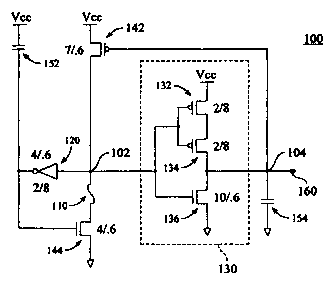Some of the information on this Web page has been provided by external sources. The Government of Canada is not responsible for the accuracy, reliability or currency of the information supplied by external sources. Users wishing to rely upon this information should consult directly with the source of the information. Content provided by external sources is not subject to official languages, privacy and accessibility requirements.
Any discrepancies in the text and image of the Claims and Abstract are due to differing posting times. Text of the Claims and Abstract are posted:
| (12) Patent Application: | (11) CA 2316977 |
|---|---|
| (54) English Title: | FUSE CIRCUIT HAVING ZERO POWER DRAW FOR PARTIALLY BLOWN CONDITION |
| (54) French Title: | CIRCUIT DE FUSIBLE AVEC PONCTION NULLE DE PUISSANCE POUR FUSIBLE PARTIELLEMENT GRILLE |
| Status: | Deemed Abandoned and Beyond the Period of Reinstatement - Pending Response to Notice of Disregarded Communication |
| (51) International Patent Classification (IPC): |
|
|---|---|
| (72) Inventors : |
|
| (73) Owners : |
|
| (71) Applicants : |
|
| (74) Agent: | SMART & BIGGAR LP |
| (74) Associate agent: | |
| (45) Issued: | |
| (86) PCT Filing Date: | 1999-06-15 |
| (87) Open to Public Inspection: | 2000-03-30 |
| Examination requested: | 2004-05-17 |
| Availability of licence: | N/A |
| Dedicated to the Public: | N/A |
| (25) Language of filing: | English |
| Patent Cooperation Treaty (PCT): | Yes |
|---|---|
| (86) PCT Filing Number: | PCT/US1999/013527 |
| (87) International Publication Number: | US1999013527 |
| (85) National Entry: | 2000-06-22 |
| (30) Application Priority Data: | ||||||
|---|---|---|---|---|---|---|
|
A fuse circuit (100) includes a fusible element (110) and a feedback path
which causes the circuit to behave as if the fusible element (110) is fully
blown even though the fusible element (110) in fact is partially intact. While
a partially intact fuse normally would result in a continuous drain of power,
the feedback path cuts of the current flow through the partially intact
fusible element (110).
Cette invention concerne un circuit de fusible (100) avec un élément de fusible (110) et un chemin de rétroaction conçu pour que le circuit se comporte comme si l'élément (110) était complètement grillé alors qu'il est en partie intact. Alors qu'un fusible en partie intact provoque normalement un ponction continue de courant, le chemin de rétroaction coupe le passage du courant au travers de l'élément de fusible (110) partiellement intact.
Note: Claims are shown in the official language in which they were submitted.
Note: Descriptions are shown in the official language in which they were submitted.

2024-08-01:As part of the Next Generation Patents (NGP) transition, the Canadian Patents Database (CPD) now contains a more detailed Event History, which replicates the Event Log of our new back-office solution.
Please note that "Inactive:" events refers to events no longer in use in our new back-office solution.
For a clearer understanding of the status of the application/patent presented on this page, the site Disclaimer , as well as the definitions for Patent , Event History , Maintenance Fee and Payment History should be consulted.
| Description | Date |
|---|---|
| Application Not Reinstated by Deadline | 2007-06-15 |
| Time Limit for Reversal Expired | 2007-06-15 |
| Deemed Abandoned - Failure to Respond to Maintenance Fee Notice | 2006-06-15 |
| Inactive: IPC from MCD | 2006-03-12 |
| Inactive: IPC from MCD | 2006-03-12 |
| Inactive: IPC from MCD | 2006-03-12 |
| Inactive: IPC from MCD | 2006-03-12 |
| Inactive: IPC from MCD | 2006-03-12 |
| Inactive: IPC from MCD | 2006-03-12 |
| Inactive: IPC from MCD | 2006-03-12 |
| Inactive: IPC from MCD | 2006-03-12 |
| Inactive: IPC from MCD | 2006-03-12 |
| Inactive: IPC from MCD | 2006-03-12 |
| Inactive: IPRP received | 2004-07-28 |
| Letter Sent | 2004-06-03 |
| Request for Examination Requirements Determined Compliant | 2004-05-17 |
| Amendment Received - Voluntary Amendment | 2004-05-17 |
| All Requirements for Examination Determined Compliant | 2004-05-17 |
| Request for Examination Received | 2004-05-17 |
| Inactive: Cover page published | 2000-10-06 |
| Inactive: First IPC assigned | 2000-10-04 |
| Letter Sent | 2000-09-21 |
| Inactive: Notice - National entry - No RFE | 2000-09-21 |
| Application Received - PCT | 2000-09-18 |
| Application Published (Open to Public Inspection) | 2000-03-30 |
| Abandonment Date | Reason | Reinstatement Date |
|---|---|---|
| 2006-06-15 |
The last payment was received on 2005-05-27
Note : If the full payment has not been received on or before the date indicated, a further fee may be required which may be one of the following
Patent fees are adjusted on the 1st of January every year. The amounts above are the current amounts if received by December 31 of the current year.
Please refer to the CIPO
Patent Fees
web page to see all current fee amounts.
| Fee Type | Anniversary Year | Due Date | Paid Date |
|---|---|---|---|
| Registration of a document | 2000-06-22 | ||
| Basic national fee - standard | 2000-06-22 | ||
| MF (application, 2nd anniv.) - standard | 02 | 2001-06-15 | 2001-01-26 |
| MF (application, 3rd anniv.) - standard | 03 | 2002-06-17 | 2002-02-14 |
| MF (application, 4th anniv.) - standard | 04 | 2003-06-16 | 2003-02-06 |
| Request for examination - standard | 2004-05-17 | ||
| MF (application, 5th anniv.) - standard | 05 | 2004-06-15 | 2004-06-01 |
| MF (application, 6th anniv.) - standard | 06 | 2005-06-15 | 2005-05-27 |
Note: Records showing the ownership history in alphabetical order.
| Current Owners on Record |
|---|
| ATMEL CORPORATION |
| Past Owners on Record |
|---|
| JAMES E. PAYNE |
| SAROJ PATHAK |